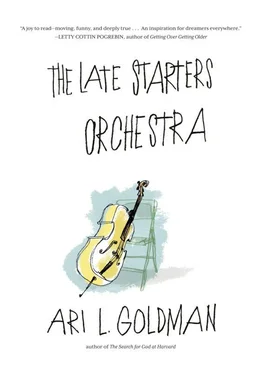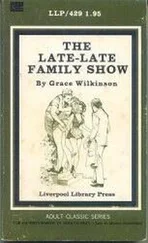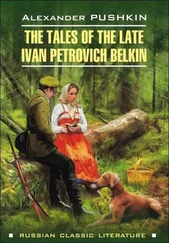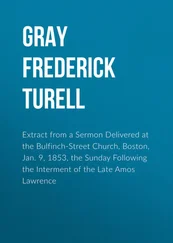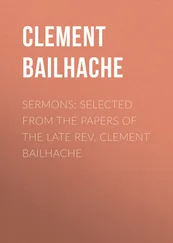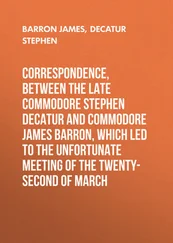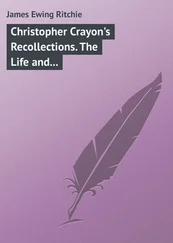In one study, conducted at the University of Kansas, researchers compared three groups of seventy healthy older adults ranging in age from sixty to eighty-three. They divided their subjects into three groups: nonmusicians, low-activity musicians (one to nine years of musical training), and high-activity musicians (ten years or more). The researchers did their best to control for every possible condition of importance, including intelligence, physical activity, and education. Still, the results showed that the more music, the better the memory, the quicker the processing speed, and the more adroit the cognitive flexibility. Music, it seemed, was able to take an eighty-year-old mind and turn it into a mind more befitting of a sixty-year-old.
You can read about the benefits of adult learning in such places as Psychology Today, a magazine where the median age of readers is forty-five. (One recent Psychology Today feature article had this headline: MUSIC LESSONS: THEY’RE NOT JUST FOR KIDS ANYMORE.) And, of course, music isn’t the only way to sharpen the mind. There are also numerous inspirational books on the market touting the value of any kind of lifelong learning, books with the titles Aging Well, The Art of Aging, From Age-ing to Sage-ing, and this one with a cautionary title, The Denial of Aging: Perpetual Youth, Eternal Life, and Other Dangerous Fantasies. Magazines like AARP often feature stories about actors, writers, and painters who come to their craft late in life. Julia Child did not even know how to cook until her late thirties; Grandma Moses didn’t pick up a paintbrush until she was in her seventies; Tillie Olsen published her first book at forty-nine; Danny Aiello didn’t act until he was forty. However, in all these compilations, there is no list of great classical musicians who start late.
Guitarists, yes, but cellists, no.
In his book Guitar Zero, Gary Marcus writes about his personal quest to learn guitar as he approaches his fortieth birthday. Marcus, a psychologist, takes comfort in the stories of rock stars who came relatively late to their craft, like Patti Smith, who didn’t seriously consider singing until her midtwenties; and Tom Morello, who didn’t pick up a guitar until his late teens.
At thirty-eight, Marcus knew that the cards were stacked against him but he believed that he could master the guitar. “I wanted to know whether I could overcome my intrinsic limits, my age, my lack of talent,” he writes. In the course of the book, he actually becomes quite competent on the guitar.
Marcus also revels in the ignorance of many famous guitarists when it comes to reading music. “None of the Beatles could read or write music,” Marcus notes, “and neither can Eric Clapton.”
It’s a good thing none of them played a classical string instrument. Cello is different. An ability to read music is required and there is no greatness unless you start young. Very young. “A string player should begin at 5,” the great violinist Alexander Schneider said. “Later is too late.”
When I was five, string instruments were the farthest thing from my life. On the eve of my sixth birthday, my mother left my father in Hartford, Connecticut, and I began a new life with her and my two brothers in a small apartment in the Jackson Heights section of Queens, New York. Her leaving was the first salvo in a divorce proceeding that was to drag on for a good part of my childhood. For me, my parents’ separation and eventual divorce meant geographic dislocation, emotional and financial hardship, and family dissention that, quite remarkably, lasts to this day, even though my parents are long gone from this earth.
The one bright spot in my young life was music. I sang. I sang on the streets and I sang in school and I sang on the subway and I sang in bed and I sang in the synagogue. I had a remarkably good, clear, and energetic voice, one with distinct timbre, flexibility, and range.
It was very important to my father that I sing in the synagogue. Music, the music of the synagogue, was a link that kept us close even as I moved away and saw him only on weekends and holidays. My father wanted me to use my gift for the glory of God. From the time I was very young, he trained me to sing the solos that a small child can lead, such as the concluding hymns of “Aleynu” and “Adon Olam.” And, most of all, he trained me for my bar mitzvah, the day that I would be able to lead the adult congregation in prayer.
On the weekends that I spent with my father in Hartford, we would rise early Saturday mornings to attend synagogue. As Orthodox Jews, we did not take the car, no matter how hot or cold the weather. We walked in winter snowstorms and in spring rain showers. In traditional Judaism, to ride in the comfort of your car is a violation of the Sabbath, but to walk in terrible weather is fine; a mitzvah, even. Outside of traditional Judaism, our walks might not make much sense, but I wouldn’t have traded that time with my dad for anything. As we made our way to synagogue, about a ten-minute-long stroll, we held hands and sang. My dad would have me practice the special songs for Shabbat and we would talk excitedly about how we could innovate with extra melodies and vocal flourishes. Our voices resounded through the early morning streets.
I was loud for a little kid and could even project in Orthodox synagogues, which, in keeping with traditional Jewish law, did not use a microphone on the Sabbath. My bar mitzvah, held at the Orthodox Young Israel of Jackson Heights in Queens, New York, in late 1962, was a festival of song — with me as the star. Most bar mitzvah boys — there were no bat mitzvah girls in Orthodox synagogues in those days — read the Torah portion (a selection from the Five Books of Moses) and the Haftorah (additional selections from the Prophets). My voice was so good and renowned in our little circle that I was allowed to take over the whole service. I led the morning prayers, Shacharit, and the so-called “additional service,” Musaf, incorporating melodies both traditional and new. I sang songs inspired by the young State of Israel and by Hasidic melodies, especially as interpreted by the singing rabbi of that era, Rabbi Shlomo Carlebach. I even incorporated some of the vocal techniques and inflections I had learned from my folk heroes. One friend told me I sounded like I was auditioning for the Kingston Trio.
Without a banjo, of course. There were no musical instruments on the Sabbath either. No banjos and certainly no cellos. The Bible is sparing in its references to instruments, most of which were played to honor festivals and kings and to accompany the sacred service in the ancient Temple. The Encyclopedia Judaica lists nineteen instruments referenced in the Bible, including the lyre, the lute, the recorder, the harp, and a variety of horns, drums, and bells. Psalm 150 includes a veritable orchestra. “Praise God in his sanctuary,” the psalm begins. “Praise him with the sound of the shofar, praise him with the harp and the lyre. Praise him with the timbrel and dance, praise him with stringed instruments and the pipe. Praise him upon sounding cymbals, praise him with loud crashing cymbals.”
The harp and the lyre were used in the ancient Temple on the Sabbath, but after the destruction of the Temple in 70 CE and the dispersal of the Jews into exile, the rabbis forbade their use on the Sabbath and were even ambivalent about music during the rest of the week. The nation of Israel was in mourning, the rabbis declared, and celebrations should be toned down. Music was still played at weddings, but even Jewish weddings are famously muted, even to this day. That is why a glass is broken. Even at our happiest moments, part of us is still in mourning for the loss of the Temple.
Читать дальше
